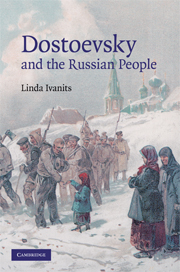Book contents
- Frontmatter
- Contents
- Acknowledgments
- Note on transliteration
- Introduction: the people in Dostoevsky's art and thought
- 1 The face of the people, 1821–1865
- 2 The world of the people in Crime and Punishment
- 3 The Idiot: where have all the people gone?
- 4 Fumbling toward Holy Russia in The Devils
- 5 Back in Russia: the face of the people, 1871–1877
- 6 The Brothers Karamazov: Christ walks the Russian land
- Concluding remarks: Dostoevsky and the people
- Notes
- Bibliography
- Index
Introduction: the people in Dostoevsky's art and thought
Published online by Cambridge University Press: 22 September 2009
- Frontmatter
- Contents
- Acknowledgments
- Note on transliteration
- Introduction: the people in Dostoevsky's art and thought
- 1 The face of the people, 1821–1865
- 2 The world of the people in Crime and Punishment
- 3 The Idiot: where have all the people gone?
- 4 Fumbling toward Holy Russia in The Devils
- 5 Back in Russia: the face of the people, 1871–1877
- 6 The Brothers Karamazov: Christ walks the Russian land
- Concluding remarks: Dostoevsky and the people
- Notes
- Bibliography
- Index
Summary
Readers of Dostoevsky will recall the dramatic events in the cell of Father Zosima that initiate the action of The Brothers Karamazov. The Karamazov family has gathered at the monastery where the youngest son Alesha is a novice so that the saintly monk can resolve a feud between the eldest son Dmitry and his father Fedor Pavlovich. They are an unlikely assortment of visitors. Fedor Pavlovich, his son Ivan, and their distant relative Miusov are non-believers who have come largely out of curiosity. Dmitry alone takes the meeting seriously, but his arrival is delayed for most of the scene. During his absence, Old Karamazov spouts travesties of biblical verses, Zosima steps out to visit a group of peasant women, and the entire company engages in a heated discussion of an article that Ivan wrote about ecclesiastical courts. Dmitry arrives, asks Father Zosima's blessing, and sits down; then the conversation turns to Ivan's thesis that if God does not exist, everything is permitted. Sensing that Ivan is in the midst of a great spiritual struggle, Zosima blesses him. Suddenly Fedor Pavlovich begins shouting scandalous accusations against Dmitry, who in turn cries out: “Why does such a man live? … Can one even allow him to defile the earth with his presence?” Old Karamazov responds, “Are you listening, are you listening, monks, to the parricide?”(14: 69). Zosima unexpectedly rises from his place, falls on his knees and bows down before Dmitry. All the visitors rush out of the room.
- Type
- Chapter
- Information
- Dostoevsky and the Russian People , pp. 1 - 7Publisher: Cambridge University PressPrint publication year: 2008



